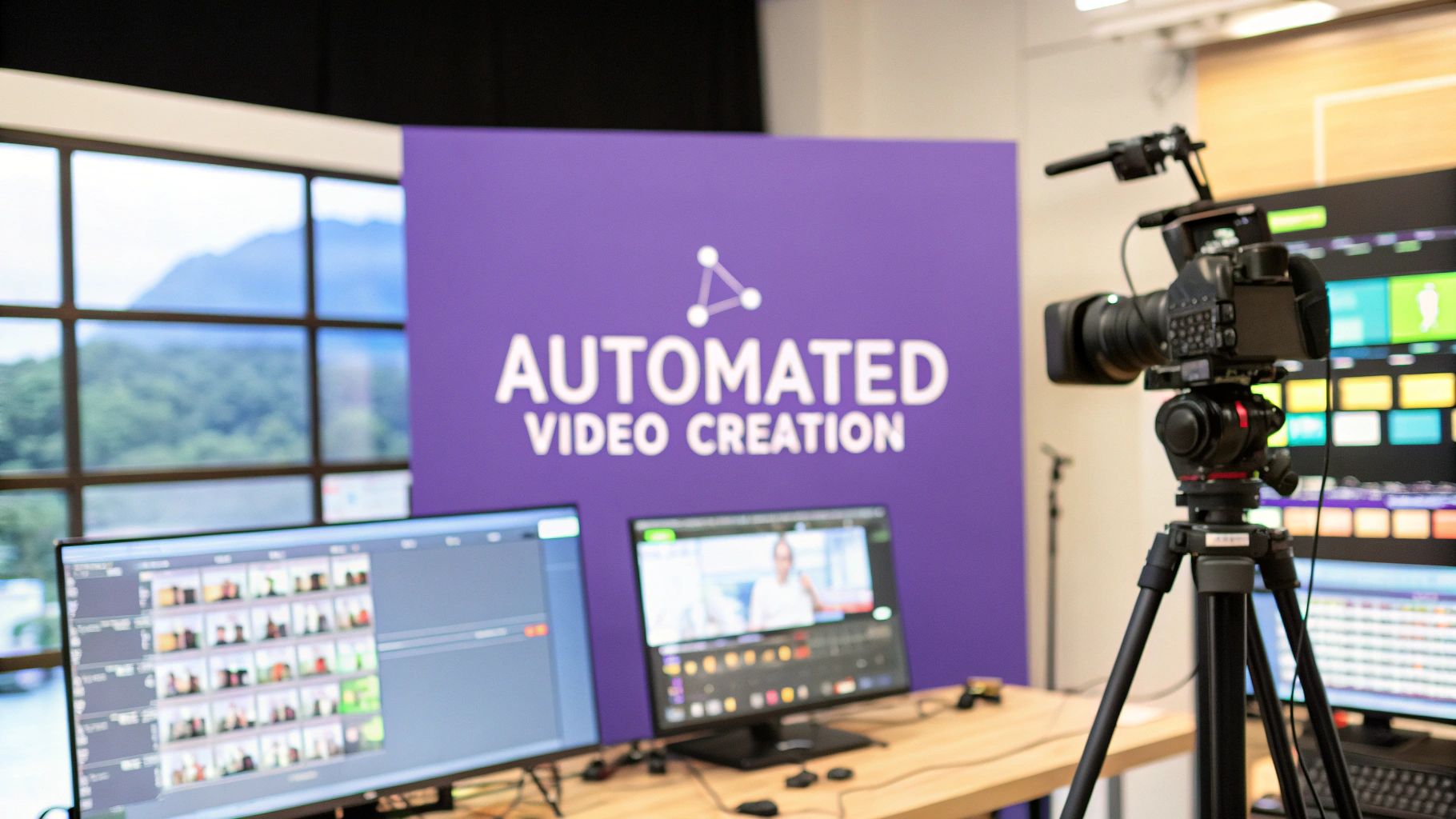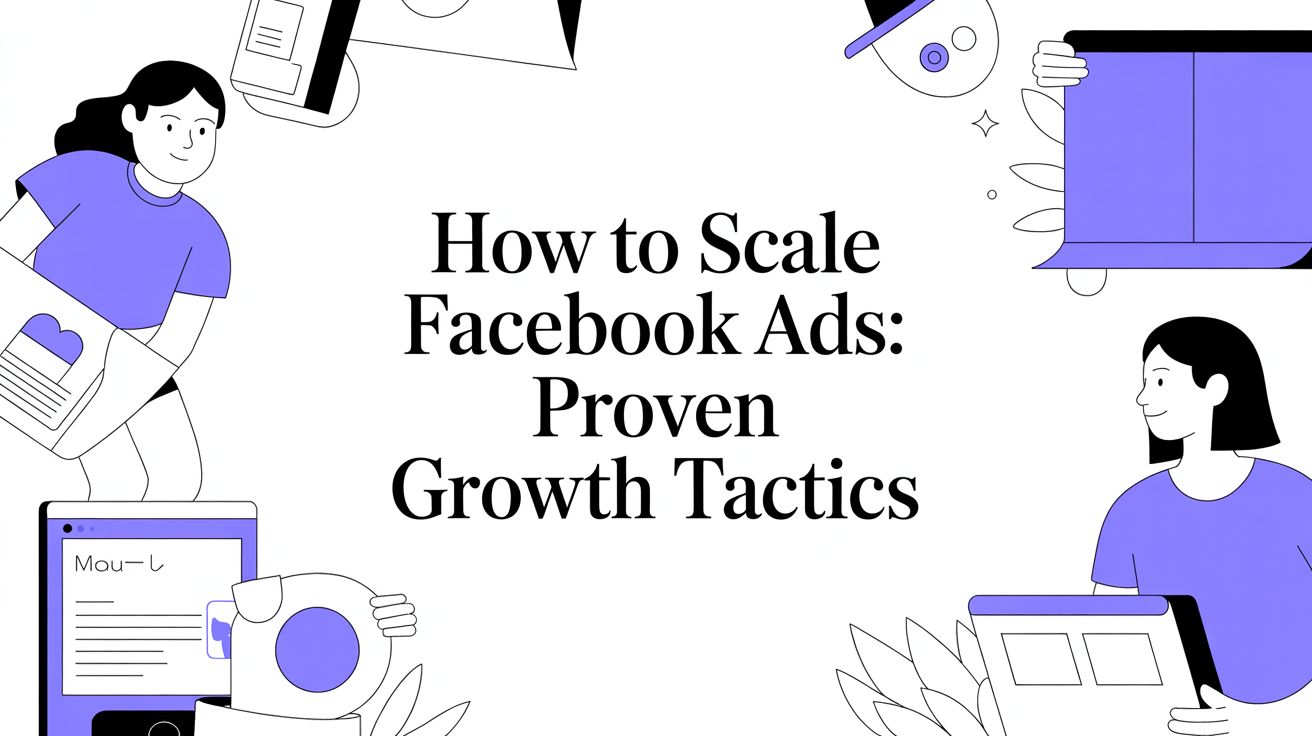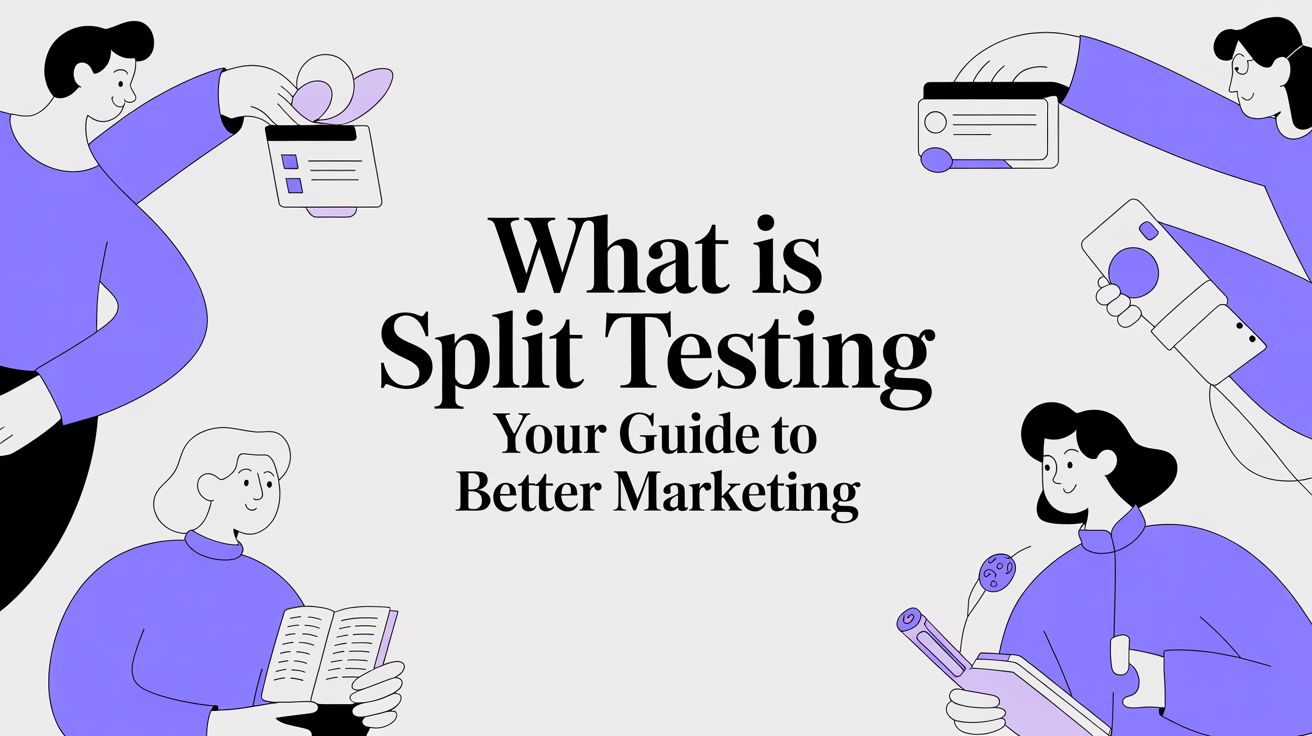Imagine having a personal video production crew on standby, ready to turn your ideas into polished, engaging videos in a flash. That's essentially what automated video creation does. It's a process that uses AI to take text, data, or other media and whip it into a finished video, all without you having to touch a single editing timeline.
What Is Automated Video Creation?

Think of it like an expert assembly line for video. You bring the raw materials—a blog post, a script, or just some product details—and the AI system gets to work. It acts like a director, automatically picking out the right visuals, generating a voiceover, adding music, and layering on text to bring it all together.
This isn't about getting rid of human creativity. Far from it. The goal is to handle all the tedious, repetitive parts of video production so you can focus on what really matters: the story, the message, and the strategy. Instead of losing days to finding the perfect clip or syncing audio, you can get a solid first draft done in minutes.
The Driving Force Behind the Trend
So, why is this technology suddenly everywhere? It all comes down to demand. Video is king online, making up around 80% of all internet traffic. That puts a ton of pressure on businesses and creators to produce more video content, and to do it faster than ever before. This need has kicked the market into high gear.
The AI video generator market, a huge piece of this puzzle, was valued at around $555 million in 2023. Projections show it rocketing to nearly $2 billion by 2030, with a compound annual growth rate of 19.9%. You can learn more about the market's rapid expansion on GrandViewResearch.com.
This isn't just a fleeting trend; it's a fundamental shift. Automation is making video creation truly accessible, putting powerful tools in the hands of small businesses, solo creators, and big companies alike—no massive budget or specialized team required.
How Does It Actually Work?
To really get what's happening behind the scenes, you have to look at the different technologies working together. An automated video system isn't just one magic tool; it's a combination of smart components that interpret your input and build a visual story from scratch. Let's break down the key parts.
Key Components of Automated Video Creation
The table below outlines the core engines that power these platforms, turning a simple script into a dynamic video.
| Component | Function | Example |
|---|---|---|
| Content Analysis Engine | This is the "brain." It reads your text to understand key themes, keywords, and emotions, then structures it into scenes. | An AI identifies the sentence "Our new software boosts productivity" and tags it as a positive, business-themed scene. |
| Media Selection Algorithm | Based on the analysis, this searches huge libraries of stock footage, images, and animations to find the perfect visuals for each scene. | For the productivity scene, it might pull a video clip of a focused team collaborating in an office. |
| AI Voiceover Generation | Advanced text-to-speech (TTS) tech converts your script into a natural-sounding human voice, often with options for different accents and languages. | Your script is read aloud by a clear, professional-sounding voice that matches your brand's tone. |
| Automated Editing | This is the final step where everything—visuals, voice, music, and branding—is stitched together into a seamless, well-paced video. | The system adds your logo, trims clips to sync with the narration, and applies smooth transitions between scenes. |
Understanding these pieces helps demystify the magic. It's a sophisticated yet logical process where each component plays a crucial role in bringing your content to life.
How AI Makes Video Automation Possible
So, how does automated video creation actually work? It’s not one single piece of magic, but rather a team of specialized AIs working together behind the scenes. Think of it less like a magic wand and more like a highly efficient film crew, where each AI has a specific job to do.
The process kicks off with an AI that's a master of language. This is where Natural Language Processing (NLP) comes in. NLP acts as the director, reading your script to understand its core message, tone, and key ideas. It’s figuring out the "what" and "why" of your video before a single frame is chosen.
Once the script is understood, Computer Vision takes over. If NLP is the director, Computer Vision is the entire production team rolled into one. It dives into massive libraries of stock footage, images, and animations to find the perfect visuals. It's not just matching keywords; it’s understanding context to find clips that truly fit the story you’re trying to tell.
This infographic breaks down some of the biggest benefits you get from this kind of intelligent workflow.
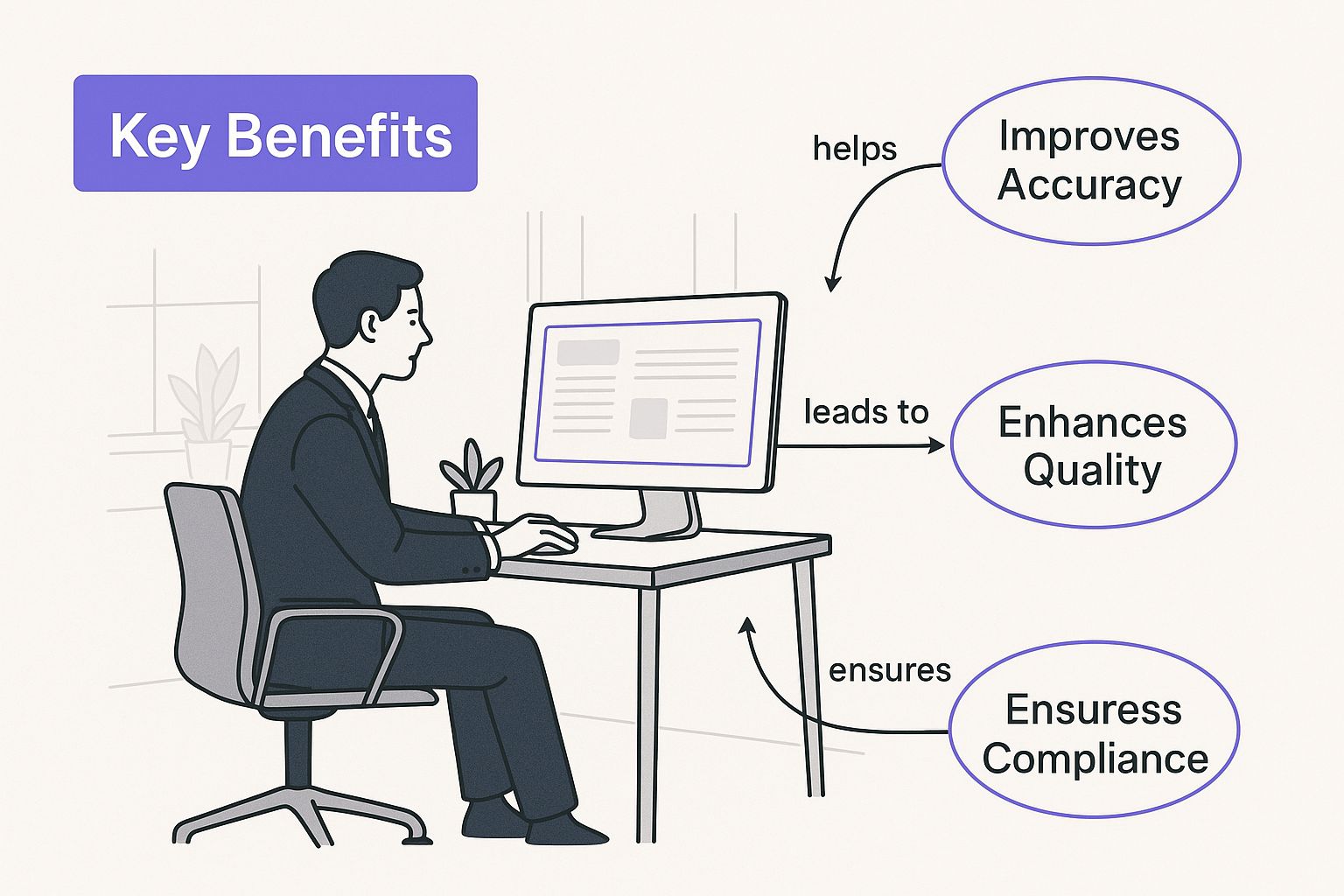
As you can see, the AI’s ability to analyze your script and automatically pick the right media is what saves so much time and makes it possible to scale up your video output.
Core AI Functions in Action
When these technologies team up, they handle all the heavy lifting that turns your text into a polished video. This is what makes automated video so powerful.
- Intelligent Script Analysis: The AI reads your script and breaks it down into individual scenes, almost like a storyboard artist would.
- Contextual Media Sourcing: For each scene, it pulls relevant video clips and images that make sense visually and support the narrative.
- Lifelike Voiceover Generation: Modern text-to-speech (TTS) engines create a natural-sounding voiceover from your script. You can even choose different voices and accents to match your brand's personality.
- Automated Brand Application: The system automatically adds your logo, brand colors, and fonts to every video, keeping everything consistent.
This coordinated process is making waves. The AI video creation market was valued at $1.05 billion in 2023 and is expected to hit $7.45 billion by 2033, growing at a massive 21.6% each year.
From Script to Screen: An Example
Let’s make this real. Imagine you have a script for a social media ad: "Our new running shoes are lightweight and perfect for city streets."
- First, NLP reads the text. It identifies the key elements: "running shoes," "lightweight," and "city streets," and picks up on the positive, energetic vibe.
- Next, Computer Vision gets to work. It finds clips of someone running through a cool city, close-ups of the sleek shoe design, and maybe an animation showing how light they are.
- Then, the TTS engine records an upbeat voiceover that sounds genuinely excited about the product.
- Finally, the system puts it all together. It adds your logo to the corner and overlays text like "Lightweight & Durable" in your brand's signature font.
The entire process takes just minutes, not hours or days. The AI handles the technical grunt work, which frees you up to focus on the bigger picture—your message and strategy. It's a true partnership between human creativity and machine efficiency.
Platforms like Sprello are designed to excel at specific formats, like the short-form vertical videos that dominate social media. If you're looking to create content for platforms like TikTok, understanding how AI is built for that purpose is a game-changer. You can see these principles in action in our guide to using an AI video maker for TikTok. This is how producing high-quality video at scale becomes a reality for pretty much anyone.
The Real-World Benefits for Your Business
So, why should you even consider bringing automated video creation into your business? The answer goes way beyond just saving a bit of time. It’s about gaining a serious strategic edge that directly impacts your marketing, your agility, and your ability to keep up with the competition.
Think of it this way: traditional video production is like commissioning a custom-built car. It requires skilled craftspeople, expensive parts, and a long wait time to get just one finished product. Automated video creation, on the other hand, is like having your own modern assembly line—you can roll out thousands of high-quality, well-designed models quickly and for a tiny fraction of the cost.
This shift allows you to move from producing a handful of big, expensive videos each year to maintaining a constant flow of fresh, relevant content that keeps your audience engaged.
Drastically Reduce Production Costs
The first thing you'll notice is how much money you save. Seriously. A traditional video shoot comes with a long list of expenses: camera gear, lighting, studio space, actors, and a post-production crew. A single, short video can easily set you back thousands of dollars.
Automated video creation gets rid of almost all of that. Instead of a whole crew, you're using a single software platform. This makes professional-looking video a real possibility for businesses of any size, especially those who thought it was completely out of reach. Our guide on small business video marketing dives deeper into how you can take advantage of this.
Accelerate Your Speed to Market
In today's market, speed is everything. If you have to wait weeks or even months to get a video out the door, you're going to miss your window. Automation crushes that timeline, taking you from idea to finished video in hours or sometimes just minutes.
Imagine a topic starts trending online and you can jump on it with a relevant video ad that very same day. Or picture having product videos ready to go the second a new item lands in your store. This kind of speed lets your brand be part of the conversation as it’s happening, not weeks later when everyone has moved on.
Scale Your Content Output Effortlessly
This might be the biggest advantage of all: the ability to scale. Trying to manually create unique videos for different customer groups, A/B tests, or all your product variations is a massive, costly headache. With automation, it's not just possible; it's easy.
A small e-commerce brand can use automation to produce unique product videos for its entire catalog of hundreds of items—a feat that would otherwise require an enormous budget and team. This levels the playing field, allowing smaller players to compete with industry giants on content volume and personalization.
If you want to get started without a team of developers, looking into no-code automation tools is a great move. They often connect seamlessly with video platforms to create a powerful and efficient content engine.
This isn't some far-off future tech; it's happening right now. Just look at OpenAI's 'Sora' model, which can create impressive one-minute videos from a simple text prompt. Or tools like Synthesia, which use AI avatars to create videos in over 60 languages. This kind of scalability turns video from a rare, special project into a consistent, central part of your marketing strategy.
Practical Uses for Automated Video
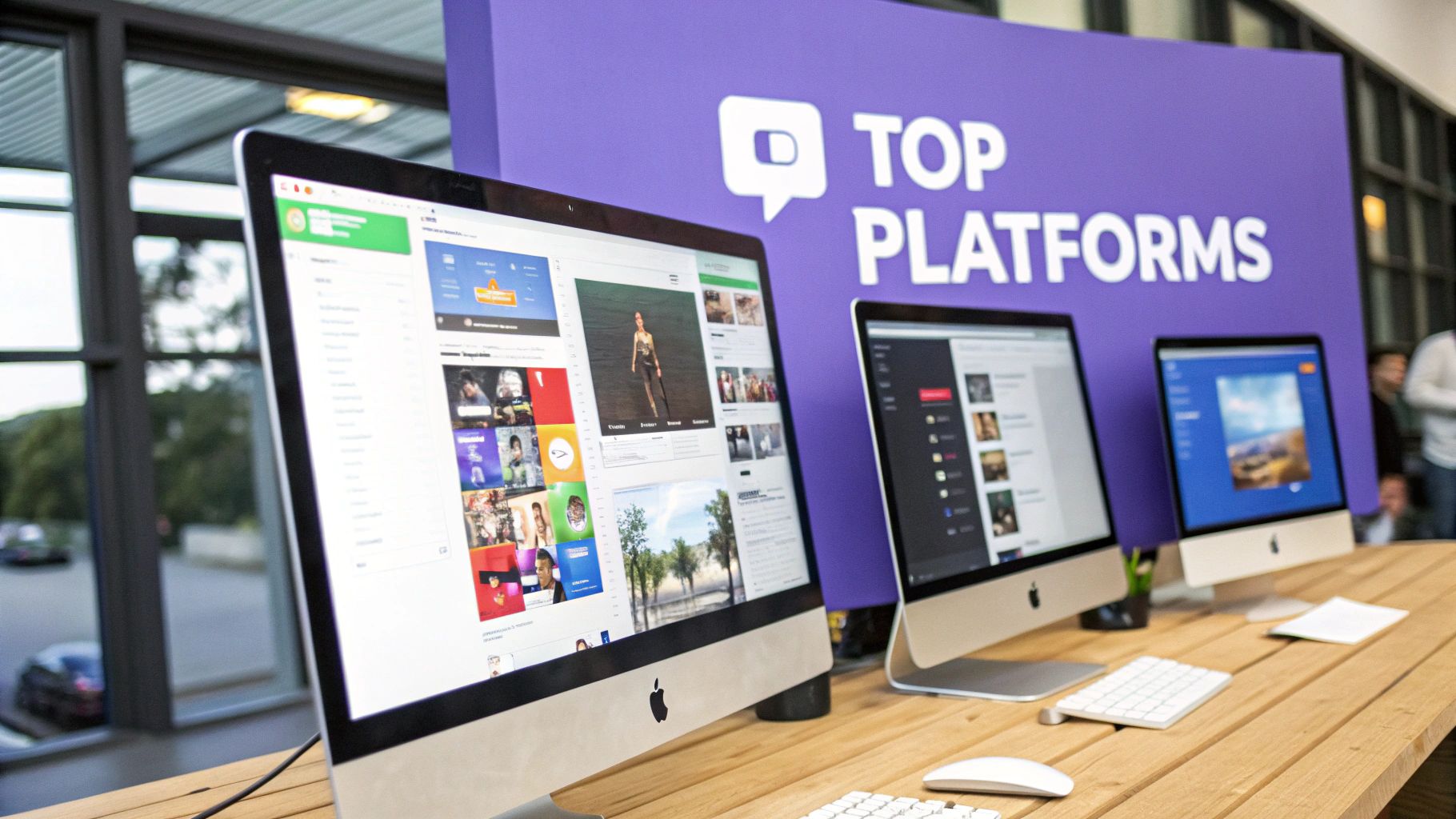
It’s one thing to talk about the theory behind AI-powered video, but the real magic happens when you see it solve actual problems. Across all sorts of industries, automated video creation isn't just a gimmick; it's a workhorse delivering real results. This is where the hype meets reality, fundamentally changing how businesses connect with people, both inside and outside the company.
Automation cracks open possibilities that used to be locked behind huge costs and endless hours of work, from social media campaigns to internal training. Let's dig into a few real-world examples of how this technology is being put to use every day.
Transforming Marketing and Social Media
If you're on a marketing team, you know the relentless pressure to churn out high-quality video content. Trying to keep up with trends, personalize ads, and A/B test everything with traditional video production can drain your budget and burn out your team—fast.
The Problem: A digital marketing agency has to create dozens of unique video ads for a client’s campaign. Each one needs to be tailored for different audiences on TikTok and Instagram. Doing this the old-fashioned way would take weeks and cost a small fortune.
The Fix: They turn to an automated video creation platform. The agency feeds it a few script variations and a folder of product assets. The AI then gets to work, generating a whole collection of short, vertical videos, each with slightly different hooks, visuals, and calls to action.
The Result: The agency cranks out 50+ video variations in just one afternoon. They can immediately start testing to see which ads connect with audiences, tweaking their campaign on the fly and delivering way better results for their client—all without breaking the bank. That kind of speed is becoming essential.
This demand is what's driving the global video creation tools market, which is projected to hit $15 billion in 2025. And it's not slowing down; the market is expected to grow at a Compound Annual Growth Rate (CAGR) of 15% from 2025 to 2033, reaching an estimated $45 billion. This boom is all about the growing need for compelling visuals in marketing, education, and business. You can find more detailed market projections and analysis to get a deeper look at where the industry is heading.
Revolutionizing E-Commerce Product Showcases
Picture an e-commerce store with hundreds, maybe even thousands of products. Creating a unique video for every single item? It's a logistical and financial nightmare that most businesses can't even consider.
The Problem: An online clothing shop wants to boost sales by adding product videos to every page. The problem is, they just don't have the time or money to film and edit thousands of clips.
The Fix: The retailer plugs in an automated system that connects directly to their store's product data. It automatically pulls product photos, descriptions, and even customer reviews to generate a simple, clean video for every item in their catalog.
The Result: Suddenly, every product page has a dynamic video that gives shoppers a much better sense of the item. This simple change leads to a 25% increase in add-to-cart rates and a major drop in returns because customers know exactly what they’re buying.
Enhancing Corporate Training and Communications
In big companies, keeping everyone on the same page with training and updates is a constant struggle. It’s tough to schedule live sessions that work for everyone, and let's be honest, long emails and dense PDFs usually go unread.
The Problem: An HR department needs to roll out a new company-wide policy and make sure every employee actually understands it. They know an email blast won't cut it, but a live webinar is a scheduling nightmare for their global team.
The Fix: The HR team grabs the key takeaways from their policy document and pops them into an automated video tool. In minutes, the AI creates a crisp, 2-minute explainer video with simple graphics, animations, and a clear voiceover.
The Result: The video is shared easily through the company's internal channels. Engagement with the new policy is 80% higher than with their old text-based announcements, and follow-up quizzes show people genuinely get it. Now, the HR team can create these updates in less than an hour, making internal comms timely and effective.
The flexibility of automated video means it can be adapted for nearly any industry goal. Here's a quick look at how different sectors are using it.
Automated Video Applications by Industry
| Industry | Primary Use Case | Key Benefit |
|---|---|---|
| Real Estate | Creating property tour videos from photos and data. | Quickly markets dozens of listings without expensive shoots. |
| Education | Turning lesson plans into animated explainer videos. | Makes complex topics more engaging and accessible for students. |
| News & Media | Converting articles into short video summaries for social media. | Increases audience reach and engagement on visual platforms. |
| Finance | Generating personalized video reports for clients. | Simplifies complex financial data and improves client communication. |
As you can see, the core idea is the same everywhere: take existing information and quickly turn it into a video that's easy to understand and share. It’s all about working smarter, not harder.
Best Practices for High-Impact Videos
Just because an automated tool makes video creation easy doesn't mean every video will be a home run. The real goal isn't just to be efficient—it's to be effective. By keeping a few key principles in mind, you can turn a good automated video into a great one that actually moves the needle for your brand.
It all starts with the script. Honestly, this is the most important piece of the puzzle. An AI can spin up a video from any text you give it, but the final result is only ever as good as your input. Before you even touch the visuals, nail down a clear, concise, and compelling story.
Think of your script as the blueprint. It sets the pace, guides the AI's visual choices, and keeps your main point from getting lost in the shuffle.
Start with a Solid Foundation
Your script doesn’t need to be an award-winning screenplay, but it does need a smart strategy. The best videos grab your attention in the first three seconds and get to the good stuff quickly.
- Hook Your Audience Immediately: Open with a question, a surprising stat, or a bold claim that piques their curiosity.
- Keep It Concise: Let's be real, attention spans are short. Trim the fat and get straight to the point. Every sentence should have a job to do.
- Focus on One Core Idea: Don't try to cram everything into one video. Stick to a single, central message to keep your audience from getting confused.
Once you have a tight script, it's time to make sure the visuals can keep up. Automation gets you started, but your creative eye is what makes it all click.
Curate High-Quality Visuals
The AI will pull from massive stock media libraries, but it’s on you to make sure the clips are the right fit. Always review the AI's suggestions and be ready to make some swaps. Look for visuals that aren't just relevant, but that also connect on an emotional level. A clip that creates the right feeling is always more powerful than one that’s just a literal interpretation of the text.
For anyone serious about getting results, it's helpful to see how automation fits into the larger video production workflow. It's a dance between AI's incredible speed and a human's creative direction.
Embrace the Human Touch
This last step is where the magic really happens: adding your unique, human touch. An AI-generated draft is a fantastic starting point, but it doesn't know your brand’s personality or the little inside jokes your audience loves. That's your job.
Review every video with a critical eye. Does the pacing feel right? Is the tone consistent with your brand voice? Does the music complement the message? Small tweaks can make a massive difference in how the video is received.
This review stage is also your chance to polish the story and weave in specific brand elements an AI would overlook. This final human check is what keeps your videos from feeling generic and ensures they ring true to your brand. It’s also the perfect time to create different versions for A/B testing. To dig deeper into that, check out our guide on automated creative testing to see how you can use variations to discover what your audience loves most.
Frequently Asked Questions
Jumping into a new technology always brings up a few questions. Even if you see the potential, it's natural to wonder about the practical side of things. Let's tackle some of the most common questions people have about automated video creation so you can feel confident getting started.
Will AI-Generated Videos Look Generic or Robotic?
That’s probably the biggest hesitation people have, and it’s a fair one. Thankfully, we've moved far beyond the early days of clunky, robotic-looking AI. The best tools today use incredibly sophisticated AI that understands context. It pulls from huge, diverse libraries of high-quality stock media to keep things looking fresh and authentic.
But here’s the most important part: the AI is there to do the heavy lifting, not to take over. It assembles a solid first draft, but you always have the final say.
The goal isn’t to create a "robot video." It's to automate the most time-consuming parts of production. You're still the creative director, adding that essential human touch by tweaking edits, swapping visuals, and making sure the final video feels 100% on-brand.
Platforms like Sprello are built for this. You can easily apply your own brand kits, select different visual moods, and fine-tune every single element until it’s perfect.
What Kind of Input Do I Need to Provide?
This is where the magic of automated video creation really shines. You don't need a perfectly polished, ready-to-shoot script. Most platforms are designed to be flexible, making it easy for anyone to get started.
You can start with something as simple as:
- A link to a blog post you've already written.
- A basic script or even just a handful of bullet points.
- The product descriptions from your online store.
- A set of key data points you want to turn into a visual story.
The AI takes this input, analyzes the core message, and then builds the video's structure, finds relevant visuals, and generates a voiceover to match. Of course, a more detailed prompt can give you a more refined first draft, but the system is smart enough to work with just a core idea.
How Much Technical Skill Is Required?
Basically, none. Seriously. These tools were built for marketers, founders, and content creators—not professional video editors. The interfaces are designed to be clean and intuitive, guiding you through the process step-by-step.
If you can write an email or post on social media, you have all the technical skills you need. The entire workflow usually just comes down to a few clicks:
- Paste your text or a URL.
- Pick a visual style you like.
- Hit the "generate" button.
Sure, there are advanced options for people who want to dive deeper and customize more, but the core experience is all about speed and simplicity. The whole point is to tear down the technical walls that made video production feel out of reach for so many.
Can I Use My Own Images and Video Clips?
Absolutely. In fact, you should! While the built-in stock libraries are fantastic for getting a video made quickly, the ability to upload your own assets is what makes the final product truly yours. This is key for brand authenticity.
By incorporating your own media, you can:
- Showcase your actual products in action.
- Feature your team and your real office space.
- Include your company logo and branded graphics seamlessly.
- Use specific B-roll footage you've already filmed.
This hybrid approach gives you the best of both worlds: the speed of AI automation with the unique, personal touch that only your own content can provide. It’s how you ensure your videos aren't just well-made, but are genuinely one-of-a-kind.
Ready to see just how fast automated video creation can be? Sprello helps you turn your ideas into high-performing, UGC-style video ads in minutes, not days. Get started with Sprello today! and see the difference for yourself.
